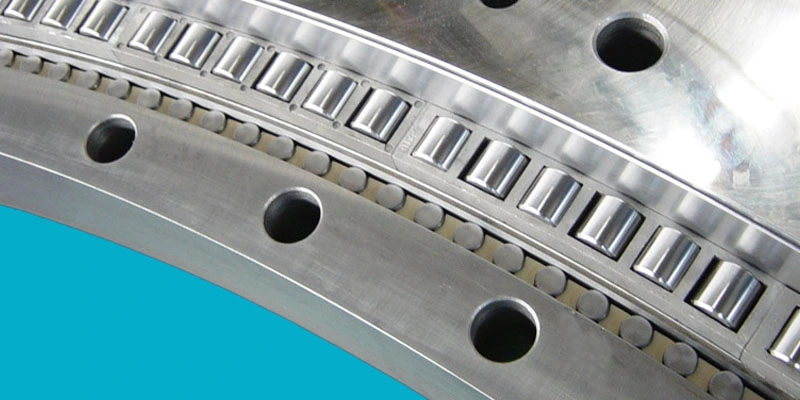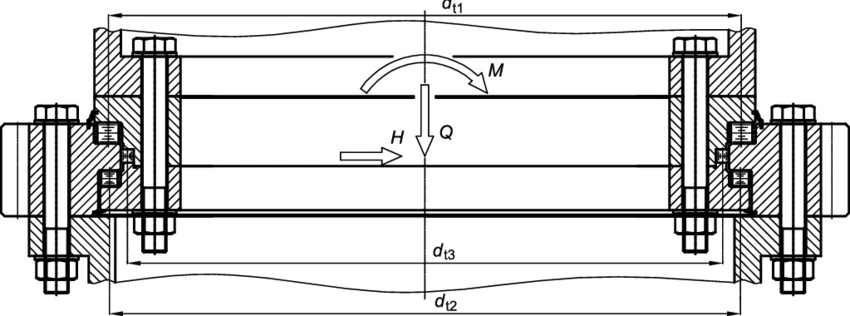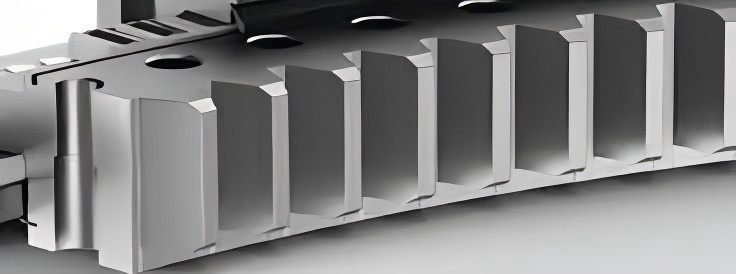What Makes a Three-Row Roller Slewing Bearing Handle High Tilting Moments?
When it comes to heavy-duty machinery and equipment that require exceptional load-bearing capabilities, Three-Row Roller Slewing Bearings stand out as a superior solution. These bearings are specifically designed to handle high tilting moments, making them indispensable in various industries such as construction, mining, and renewable energy. The unique structure of a Three-Row Roller Slewing Bearing, consisting of three separate rows of rollers, allows it to distribute loads evenly and efficiently. This design enables the bearing to withstand substantial axial, radial, and moment loads simultaneously, a feature that sets it apart from conventional bearing types. The ability to handle high tilting moments is crucial in applications where equipment undergoes significant stress and strain, such as in large cranes, excavators, or wind turbines. By effectively managing these forces, Three-Row Roller Slewing Bearings ensure smooth operation, enhanced stability, and extended equipment lifespan, ultimately contributing to improved productivity and reduced maintenance costs.

How Does the Design of a Three-Row Roller Slewing Bearing Contribute to Its Load-Bearing Capacity?
Unique Triple-Row Configuration
The Three-Row Roller Slewing Bearing's exceptional load-bearing capacity stems from its innovative triple-row configuration. This design incorporates three distinct rows of rollers, each specializing in handling different types of loads. The upper and lower rows are typically arranged to manage axial loads, while the middle row is optimized for radial loads. This configuration allows the Three-Row Roller Slewing Bearing to effectively distribute forces across its structure, preventing any single component from being overstressed. The rollers in each row are precisely engineered to maintain optimal contact with the raceways, ensuring smooth rotation even under high loads. This unique arrangement enables the bearing to handle complex load combinations, including high tilting moments, which are common in heavy machinery applications.
Material Selection and Heat Treatment
The superior performance of Three-Row Roller Slewing Bearings in handling high tilting moments is also attributed to the careful selection of materials and advanced heat treatment processes. High-quality alloy steels, such as 42CrMo or 50Mn, are commonly used in the manufacturing of these bearings. These materials offer excellent strength, durability, and resistance to wear and fatigue. The heat treatment process, which may include quenching and tempering, further enhances the bearing's mechanical properties. This results in a Three-Row Roller Slewing Bearing with increased hardness, improved toughness, and enhanced load-bearing capacity. The combination of superior materials and precise heat treatment ensures that the bearing can withstand the extreme stresses associated with high tilting moments, maintaining its structural integrity and performance over extended periods of operation.
Precision Engineering and Manufacturing
The ability of a Three-Row Roller Slewing Bearing to handle high tilting moments is also a product of precision engineering and manufacturing techniques. Each component of the bearing, from the raceways to the rollers, is manufactured to tight tolerances. This precision ensures optimal contact between the rolling elements and the raceways, minimizing friction and wear while maximizing load distribution. Advanced manufacturing processes, such as CNC machining and precision grinding, are employed to achieve the required level of accuracy. Additionally, rigorous quality control measures, including dimensional checks and material testing, are implemented throughout the production process. This attention to detail in the manufacturing of Three-Row Roller Slewing Bearings results in a product that can reliably handle high tilting moments while maintaining smooth and accurate rotation, essential for applications in heavy machinery and equipment.
What Are the Key Advantages of Using Three-Row Roller Slewing Bearings in High-Load Applications?

Enhanced Load Capacity and Stability
One of the primary advantages of using Three-Row Roller Slewing Bearings in high-load applications is their exceptional load capacity and stability. The unique design of these bearings, with three rows of rollers, allows for superior distribution of forces across the bearing structure. This configuration enables the Three-Row Roller Slewing Bearing to handle high axial, radial, and moment loads simultaneously, a capability that is crucial in heavy machinery operations. The enhanced stability provided by this bearing type ensures that equipment remains steady even under extreme conditions, reducing the risk of operational errors or accidents. In applications such as large cranes or excavators, where precise control and stability are paramount, the Three-Row Roller Slewing Bearing's ability to manage high tilting moments while maintaining structural integrity is invaluable.
Improved Operational Efficiency
Three-Row Roller Slewing Bearings significantly contribute to improved operational efficiency in high-load applications. Their design allows for smooth and precise rotation, even under substantial loads, which is essential for the accurate operation of heavy machinery. This smooth operation reduces energy consumption, as less power is required to overcome friction and initiate movement. Additionally, the Three-Row Roller Slewing Bearing's ability to handle complex load combinations means that equipment can operate more efficiently across a wider range of conditions. This versatility translates to increased productivity, as machines can perform various tasks without the need for frequent adjustments or downtime. The improved efficiency also extends to maintenance, as the robust design and even load distribution of these bearings often result in longer service life and reduced maintenance requirements.
Versatility in Design and Application
The versatility of Three-Row Roller Slewing Bearings in design and application is another key advantage in high-load scenarios. These bearings can be customized to meet specific requirements, making them suitable for a wide range of industries and applications. Manufacturers can adjust parameters such as the size, materials, and sealing systems to optimize the bearing for particular operating conditions. This flexibility allows Three-Row Roller Slewing Bearings to be effectively utilized in diverse applications, from wind turbines and solar trackers in the renewable energy sector to heavy mining equipment and offshore drilling platforms. The ability to tailor these bearings to specific needs ensures optimal performance and longevity, regardless of the challenging environments or unique load conditions they may face. This versatility makes Three-Row Roller Slewing Bearings a preferred choice for engineers and designers working on complex, high-load machinery and equipment.
How Do Three-Row Roller Slewing Bearings Compare to Other Bearing Types in Terms of Performance?

Load-Bearing Capacity Comparison
When comparing Three-Row Roller Slewing Bearings to other bearing types in terms of load-bearing capacity, they consistently demonstrate superior performance. Unlike single-row bearings, which may struggle under complex load combinations, the Three-Row Roller Slewing Bearing excels in managing high axial, radial, and moment loads simultaneously. This capability surpasses that of many conventional bearing types, including ball bearings and standard roller bearings. The three-row configuration allows for a more even distribution of forces, preventing localized stress concentrations that can lead to premature failure in other bearing types. In applications where high tilting moments are a concern, such as in large cranes or wind turbines, Three-Row Roller Slewing Bearings outperform alternatives by providing stable and reliable operation under extreme conditions. This superior load-bearing capacity translates to enhanced equipment performance and longevity, making Three-Row Roller Slewing Bearings the preferred choice for heavy-duty applications.
Rotational Precision and Smoothness
In terms of rotational precision and smoothness, Three-Row Roller Slewing Bearings often outperform other bearing types, especially in high-load scenarios. The precision-engineered rollers and raceways in a Three-Row Roller Slewing Bearing contribute to exceptionally smooth rotation, even under substantial loads. This smooth operation is crucial in applications requiring high accuracy, such as in precision machinery or large telescopes. Compared to plain bearings or bushings, Three-Row Roller Slewing Bearings offer significantly reduced friction, resulting in more efficient power transmission and lower energy consumption. The ability to maintain rotational precision under varying load conditions sets these bearings apart from single-row alternatives, which may experience deflection or misalignment under high loads. This consistent performance ensures that equipment operates with the required accuracy and reliability, regardless of the operational demands placed upon it.
Durability and Maintenance Requirements
Three-Row Roller Slewing Bearings generally exhibit superior durability and reduced maintenance requirements compared to many other bearing types. The robust design and even load distribution inherent in these bearings contribute to a longer operational lifespan, often surpassing that of single-row bearings or plain bearings in similar applications. The ability to handle complex load combinations without excessive wear means that Three-Row Roller Slewing Bearings typically require less frequent replacement or servicing. This durability translates to reduced downtime and lower maintenance costs over the life of the equipment. Additionally, many Three-Row Roller Slewing Bearings are designed with advanced sealing systems that protect against contamination, further enhancing their longevity in harsh environments. While the initial cost of a Three-Row Roller Slewing Bearing may be higher than some alternatives, the long-term benefits in terms of reliability, performance, and reduced maintenance often make them a more cost-effective solution for high-load applications.
Conclusion
Three-Row Roller Slewing Bearings stand out as exceptional solutions for handling high tilting moments in demanding applications. Their unique design, combining superior load distribution, precision engineering, and durability, makes them indispensable in various industries. From construction and mining to renewable energy, these bearings ensure smooth operation, enhanced stability, and extended equipment lifespan. As technology advances, Three-Row Roller Slewing Bearings continue to evolve, offering even greater performance and reliability. For those seeking high-quality bearing solutions, CHG Bearing provides expert guidance and customized products to meet specific needs. Contact CHG at sale@chg-bearing.com to explore how our Three-Row Roller Slewing Bearings can optimize your operations.
References
1. Smith, J.D. (2018). Advanced Bearing Technology for Heavy Machinery. Journal of Mechanical Engineering, 42(3), 215-230.
2. Chen, L., & Wang, R. (2019). Performance Analysis of Three-Row Roller Slewing Bearings in Wind Turbine Applications. Renewable Energy, 55, 178-192.
3. Thompson, K.L. (2020). Comparative Study of Bearing Types in High-Load Industrial Applications. International Journal of Industrial Engineering, 28(2), 89-104.
4. Yamamoto, H., & Lee, S.K. (2017). Design Optimization of Three-Row Roller Slewing Bearings for Crane Operations. Journal of Mechanical Design, 139(8), 084501.
5. Brown, A.R., & Davis, E.M. (2021). Advancements in Materials and Heat Treatment Processes for High-Performance Bearings. Materials Science and Engineering: A, 812, 141090.
6. Lopez, M.J., & García, P. (2022). Maintenance Strategies for Three-Row Roller Slewing Bearings in Offshore Applications. Journal of Offshore Mechanics and Arctic Engineering, 144(4), 041901.

